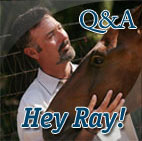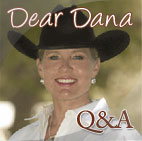Next chapter: Collected stops
52nd in a series
Last issue, Les wrapped up his detailed lessons on turn-arounds. Now we’ll open the door to stops.
Starting turnarounds: The keys
51st in a series
Last issue, Les listed details we should look for when troubleshooting our progress. Now we’ll head into turnarounds with a few keys to have in our focus.
Troubleshooting: What to look for
50th in a series
Last issue, Les finished up details of turnaround exercises. Now, we’ll look at what we’ve covered, and how to keep our efforts on track.
Turnaround Exercises: On the fence
49th in a series
Last issue, Les put us to work with basic exercises of the turnaround. Now we’ll add a couple new ones.
Turnarounds: Exercises
48th in a series
Last issue, we looked in detail at leg and rein positions. Now we can put it to work with some exercises.
The exercises we’ll work on here are just the beginnings of the turnaround. Even if your horse really starts to get it, I don’t want you to even think about speed at this point. What you’re looking to establish is the turning cue, the basic footwork and smooth cadence. When he really learns the movement, adding the speed won’t be a problem; however, to try for speed before he’s confident with the movement can scare him, frustrate him and make him start to dread, rather than enjoy, his training.
Turnaround: Stay straight up and down
47th in a series
Last issue, Les introduced us to turnarounds – one crossover step at a time. Here is a review of key points for the turnaround before we start exercises next issue.
Turn Part II: You’ll feel when it’s right
46th in a series
After starting us off with the turn-around last issue, Les gives us details along the way.
When you first start the exercise, I think it’s a good idea to push him up with both legs and then open your inside leg as you start the turn to help the horse find the move that you’re after. Also, approaching the turn with some inside leg will discourage your horse from leaning on your inside rein as you start to turn. If you feel him starting to lean, you might want to go back to exercise number two for a while and lighten him up. One thing to be careful of is that if he starts to lean or twist his head in the turnaround, he could end up shifting his weight to the outside hind leg, rather than the inside. We’ll be riding him into the turn with both legs once he gets the hang of it, but opening your inside leg at first is fine and can help your horse along.
The turn: Here’s how you start
45th in a series
After reviewing fundamentals of spins in the last issue, we’re ready to start the turn-around.
So how do we start to teach the turnaround? We start by walking in a circle about 10 feet in diameter. You want to use your circle to establish the correct bend, so bring your circle down to where your horse’s spine is bent evenly and you can just see the corner of the horse’s eye.
Now let’s stop here and think about the difference between this forward circle and the turnaround. In the turnaround, we will want to maintain the same bend and the same cadence (or rhythm), at least at this level. We want the front legs to keep moving, we want the outside back leg to keep moving, but we just want to slow down, or even stop, the forward movement of the inside hind leg. And to do that you’ll just want to check a little with your outside rein while you keep driving with your legs, and making sure the inside rein maintains the bend. As I’ll describe, when I first start to ask the horse to step across, I’ll open up my inside leg to help him understand what I want, but as he gets better at it, there are a lot of times I will ride into the turn with both legs on him.
When you’re ready to turn (or, at least, to ask for a crossover step or two), you’ll start in your circle and then ask your horse to spiral down by keeping the bend with the inside rein, drawing (pulling back) a little with the outside rein, pushing with the outside leg and opening up the inside leg. We’re loading, by restricting him with the rein and pushing with the leg, and then unloading, by taking off the inside leg and showing him that that’s where we want the energy to go. As soon as you feel one crossover step, release any pressure on your outside rein, change legs, and let him walk forward into the circle, or lateral flexion, that we started with. You want to try to maintain your bend the whole time by with just a light touch when you need it, with your inside rein.
Sounds simple, right? Well, let’s go back and talk about each element because I want you to understand why they’re important and how they work together. Plus, I want you to be able to visualize what you are looking for before you try it on your horse. First, the bend is critical. As you ask for the crossover step, you need to make sure that you’re not letting the head get out of position. If you lose any softness in his head and neck, abort the turn and go back to getting that component correct. The horse’s bend is just critical to the turnaround. Also, if the horse is leaning on your inside rein at all, don’t attempt any crossover steps. You can actually create this problem yourself if you don’t use your outside leg all the way back in the hip position. Applying pressure in the front or middle positions will make the horse think you want him to arc around that leg – and he’ll want to bend the wrong way!
EDITOR’S NOTE: More with Les is a regular California Horsetrader column. Les Vogt has won more than 15 World Championships, including two wins at the NRCHA Snaffle Bit Futurity. Although Les still rides and occasionally shows, his focus is giving clinics around the world and developing products for the performance horseman. To learn more about Les and to see his clinic schedule, visit: www.lesvogt.com
Starting Spins: Time for some fun!
44th in a series
After focusing on collection the last issue, we can move ahead into some new skills.
Now that you’ve established some body control in your horse with the exercises you’ve worked on in the previous levels, it’s time to start doing something really fun! The turnaround, when it’s done well, can be one of the most exciting parts of a reining pattern, both to ride and to watch!
Collection problems: Check the neck!

43rd in a series
After sharing insight on components of collection last issue, Les points out cause and effect of key obstacles.
In my clinics I run into a lot of horses that are fairly advanced but often they have got a hole in them. And the common problem and the common fix are going to be the same and it’s the neck. Often times these horses have an attitude in certain places. Every now and then they decide to rebel, to defy you. And what area of the horse shows defiance first? The neck! If it stiffens up, it’s the first signal that you are about to go for a ride that you’re not asking for.



 Read Columns
Read Columns

